This page was founded on the Helicogyre, but I am planning to change the name to something like 'Rotorcraft with the means of rotation built into the rotor blades' if I can find any succinct way of expressing that.
THE HELLESEN-KAHN HELICOPTER
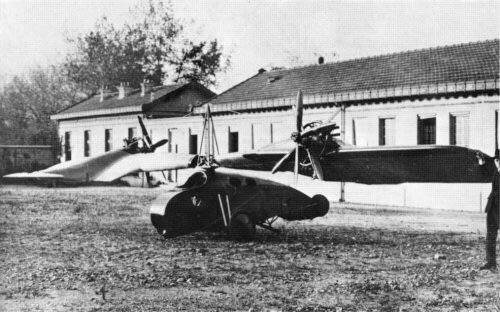 |
| Left: The Hellesen-Kahn helicopter: 1925
If the Curtiss-Bleecker helicopter looked "rather like a merry-go-round of four small monoplanes." then this machine looked like two small aeroplanes chasing each other.
Construction was begun in January 1924. In March 1925 it rose a short distance from the ground piloted by Mr. Hellesen. A contemporary report said: "Since then many special problems of stability and control have had the attention of investors." I'll bet.
The report continued: "Each aeroplanes is fitted with a 70 HP Anzani engine driving a four-bladed airscrews When the engines are running the two aeroplanes circle round the pivot at not more than 100 revolutions per minute, and exert lift upon the nacelle. The total weight of the machine is 1,764 lb. The span is 42.6 ft, the surface about 210 square feet, and the area swept by the rotating wings 1,421 square feet."
|
THE CURTISS-BLEECKER SX-5-1 HELICOPTER
The Curtiss-Bleecker SX-5-1 helicopter, introduced in 1926, had a unique means of driving the rotor. A 420 HP Pratt & Whitney engine attached to the underneath of the rotor drove four propellors on the rotor blades through shafting. This had the advantage that there was no torque reaction from the rotor, and so no tail rotor or equivalent was required. Yaw was controlled by a "Spin Vane" operated by foot pedals; this interacted with the rotor downwash to turn the aircraft.
The SX-5-1 was designed by Maitland B. Bleecker, and built by Curtiss Wright for $250,000 over the course of four years.
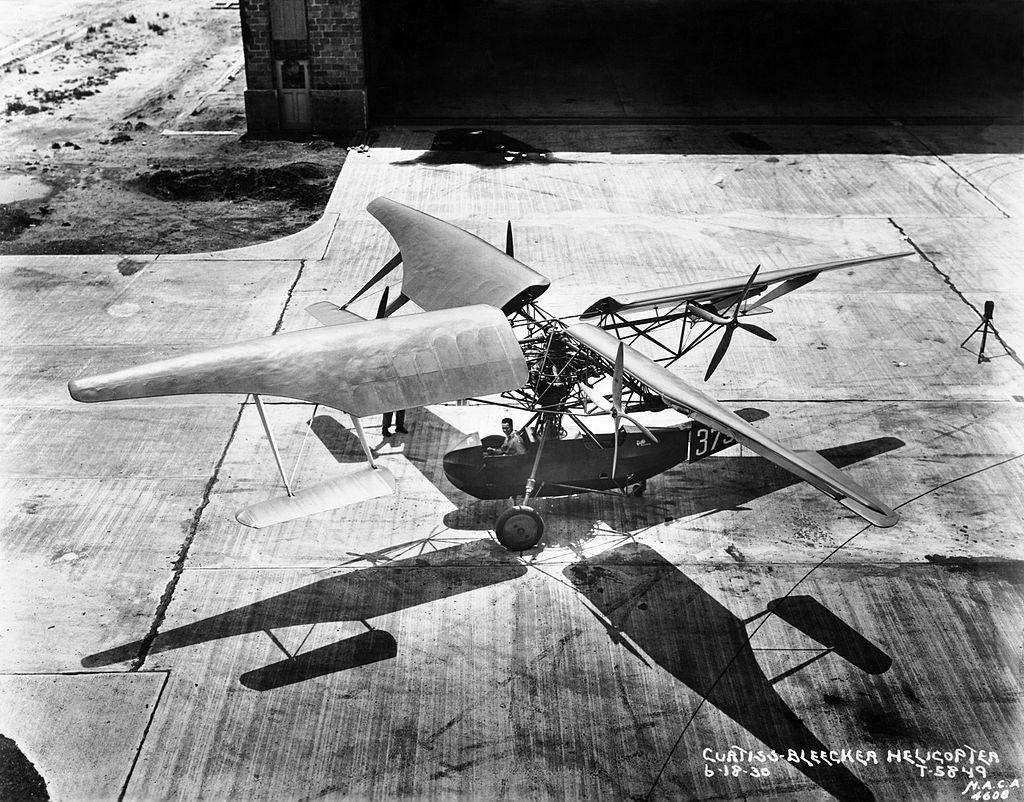 |
| Left: The Curtiss-Bleecker SX-5-1: 1926
It has been said: "...this intricate aircraft looked rather like a merry-go-round of four small monoplanes." and it is hard to argue with that. Each wing of the rotor carried a trailing control surface called a "stabovator" to change the angle of attack.
There is a Wikipedia page
There is more information at Aviastar.
|
THE ISACCO HELICOGYRE
This extraordinary machine was found in Volume 4 of "Newne's Pictorial Knowledge" an indispensable reference for those concerned with unusual means of transport.
The Associate Editor was... Enid Blyton, rather more famous in other literary fields.
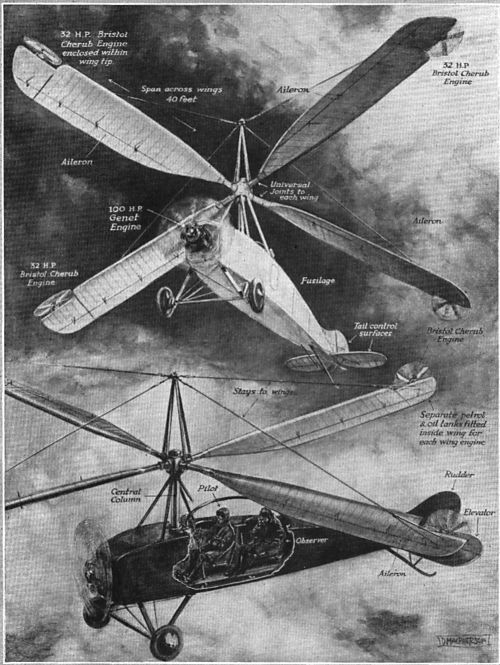 |
| Left: The Helicogyre: 1929. I have not yet located an actual photograph
The Helicogyre was a form of autogyro, with special arrangements for driving the rotor for vertical takeoff and landing. (VTOL) The designer was an Italian chap called V Isacco.
In level flight the rotor of an autogyro autorotates to provide lift and is not driven by an engine.
Conventional autogyros used a shaft drive from the main engine to spin up the rotor for takeoff, but the unique feature of the Helicogyre was the provision of four small piston-engines at the rotor tips to turn the rotor. The 32hp Bristol Cherub appears to have been chosen.
This has some advantages- for example, there is no torque reaction on the body of the aircraft as it does not provide the rotor drive, and so a tail-rotor is not required. (though there must presumably still be some tendency to rotate due to bearing friction)
On the downside, there are five engines to go wrong instead of one. The consequences of one of the four rotor engines stopping in mid-flight are not entirely clear; is the rotor head built strongly enough to redistribute the torque from the remaining engines?
There would also be some interesting problems to be solved in getting throttle control to the engines and instrumentation readings back.
The picture shows a pilot and observer, which seems to indicate intended military use.
From Volume 4 of "Newne's Pictorial Knowledge". The full set consists of 10 volumes and an Atlas volume.
|
Unlikely as it may appear, one of these was actually built in 1929 under the auspices of the British Air Ministry. They had previously encouraged the Brennan helicopter, from 1919 to 1926, at the Royal Aircraft Establishment, Farnborough.
It was not successful (who would have thought it?) and Isacco worked on other projects until after the Second World War when he came to England from France to work with Bevan Brothers on a jet-powered version of the Helicogyre, the Jetcopter. The Jetcopter project (specification E.1/48.) was abandoned in 1951.
The concept of the tip-driven rotor reappeared with considerable success in the Fairey Jet Gyrodyne of 1955 and the Fairey Rotodyne in 1957. The Rotodyne was an entirely sound design with two wing mounted Napier Eland turbo-props, mounted on stub wings, for forward flight. Air bled from the compressor stages was fed to rotor-tip combustors for take-off and landing. For various reasons, including tightening noise regulations, (the rotor-drive system was not quiet) this design did not enter quantity production.
THE MAIER HELICOPTER
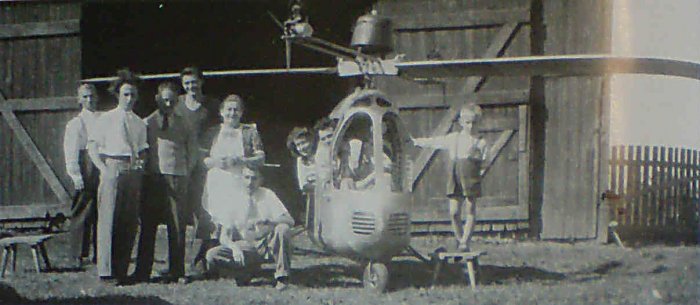 |
| Left: The Maier helicopter: 1951
This helicopter, which appears to be amateur-built, has its rotor powered by two single-cylinder engines mounted on a separate bar from the rotor blades. The only information I have is from this site, which shows an article about the machine which appears to be in Czech or Serbian, or something of that ilk. The article itself is dated 2009, but the only dates visible in the text range from 1944 to 1951, so that was presumably the period of its development and building.
Until someone translates the article, I don't think we're going to find out more. The Maier helicopter is otherwise unknown to Google.
|
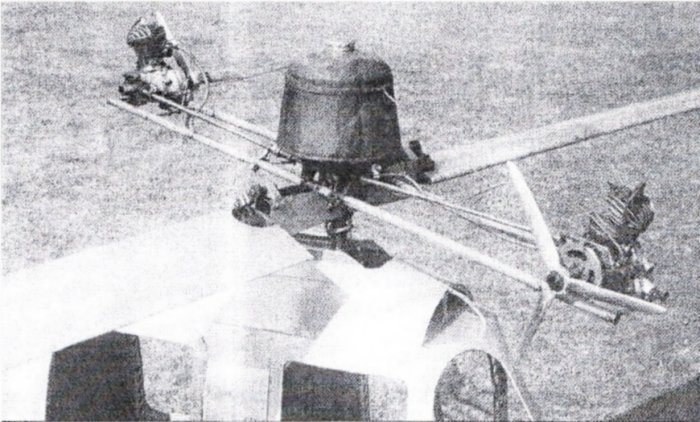 |
| Left: The Maier helicopter: 1951
The power-plant of the Maier helicopter. There are two single-cylinder engines, each driving a three-blade propellor. I suspect the conical thing above the hub is the fuel-tank, which avoid the problem of trying to feed petrol through a rotating bearing. It does not look big enough for very long flights...
|
THE FAIREY ROTODYNE
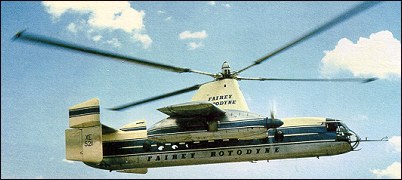 |
| Left: The Fairey Rotodyne: 1957
I built an Airfix kit of one of these. It must have been a very long time ago, as I seem to recall that it was still regarded as "transport of the future" at the time.
The rear doors were tricky to assemble, I remember...
|
THE VOLOCOPTER
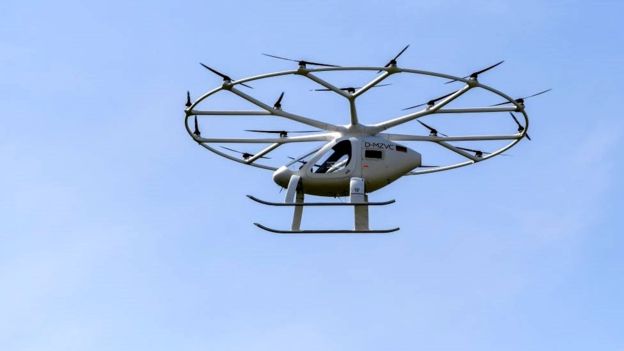 |
| Left: The Volocopter: 2019
This startling aircraft does not really fit the criteria for inclusion on this page, as the big round assembly carrying all the mini-rotors does not, as far as I can gather, itself rotate. However I hope you will agree it is worth a look. The Volocopter is intended as an air taxi and a prototype flew across Singapore's Marina Bay in October 2019. There are 18 electrically powered mini-rotors; this configuration is claimed to reduce the noise signature.
The Volocopter can be seen on this BBC page.
There is a Wikipedia page.
Here is the home page of the Volocopter company.
|













